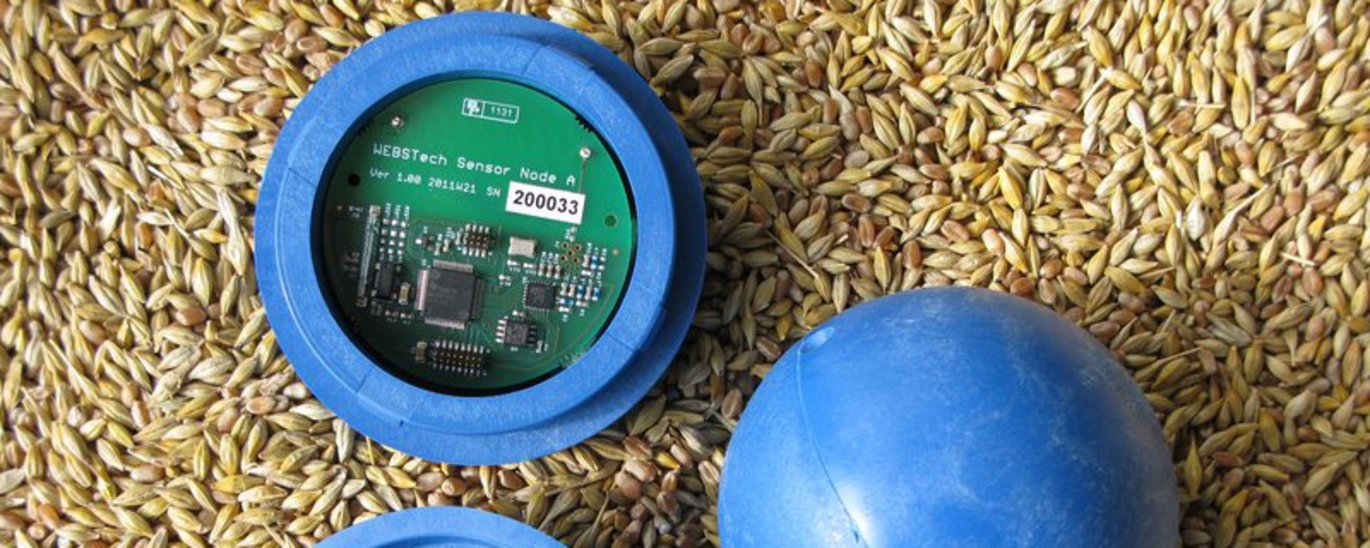Keep your eye on the ball – and save money
Science and commerce have joined forces to develop a wireless system for monitoring crops during storage.

Crops are often stored for prolonged periods before they are further processed. However, grain may deteriorate and even go to waste because storage conditions are not always optimal.
In a recently completed PhD project, Jakob Pilegaard Juul from the Department of Engineering at Aarhus University designed and developed a system that uses wireless sensors to monitor crop stores on farms.
The system can help the farmer prevent losses of biomass and income by detecting the conditions that can potentially degrade the quality of the biomass and allowing the user to promptly act on such information.
- The farmer will usually test the storage conditions by putting his hand on the grain, but this gives an incomplete picture of the actual situation. Another solution is for the farmer to monitor the store using wired sensors, but this is an expensive and time-consuming method. The aim of this project was therefore to design a wireless system that is cheap and easy to run, says Jakob Pilegaard Juul, who was attached to Kongskilde Industries A/S during the project period.
Precise information about storage conditions
The system consists of a number of wireless sensor balls that can measure and record changes in temperature and humidity. The balls are dispersed in the grain and send data to a base station coupled to the network. The farmer can then get a picture of the temperature and humidity situation in the grain via his computer, mobile phone or tablet and illustrated with graphs and temperature curves. The measurements can thus be used directly to control the drying and cooling of the crop.
It is also possible to set the system to send an alarm if storage conditions become too hot or cold, or if one or more sensors measure values that differ too much from the average of the measurements of the entire system.
During the project, the system has been commercialised and deployed on a large number of farms. Most farmers use the system to monitor grain or seed, but other uses include temperature monitoring in compost heaps or on golf courses.
- We have done a great deal to make it easy for the user to operate the system and to read data. Most are actually surprised when they first start using the system. They get more accurate information about the storage conditions, which means that many farmers actually discover that there is much more going on in the store than they had thought, says Jakob Pilegaard Juul.
Sensors on standby
One of the properties that the developers had particular focus on was that sensors need to have a long battery life. Because they are wireless, they cannot be connected to a power source – plus it's cumbersome and costly to dig the sensors out if the battery needs recharging or replacing during the storage period.
- The situation in the grain does not change much in an hour – it’s a biological process that often takes place over several days. So we have adjusted the components to only transmit data once every hour, which means that the sensors are actually in standby mode 99 percent of the time. This gives a very long battery life, says Jakob Pilegaard Juul.
One of the areas that still requires some work is on optimising the positioning of the sensors. As it stands, the farmer has to make a note him/herself of where the balls are located in the pile – in other words, individual balls cannot be located automatically.
- In order to extend the capabilities of the system, we have looked at various methods of localising the position of a sensor in a pile, but this is something that still requires some work, says Jakob Pilegaard Juul.
Further information
The PhD study was carried out at the Department of Engineering, Faculty of Science and Technology, Aarhus University, in partnership with Kongskilde Industries A/S.
Contact
PhD Jakob P. Juul
Kongskilde Industries A/S
Cell: 53 29 45 94
Mail: JPJ@kongskilde.com
Senior researcher Rasmus Nyholm Jørgensen
Department of Engineering, AU
Mail: rnj@eng.au.dk
Cell: 21628277
